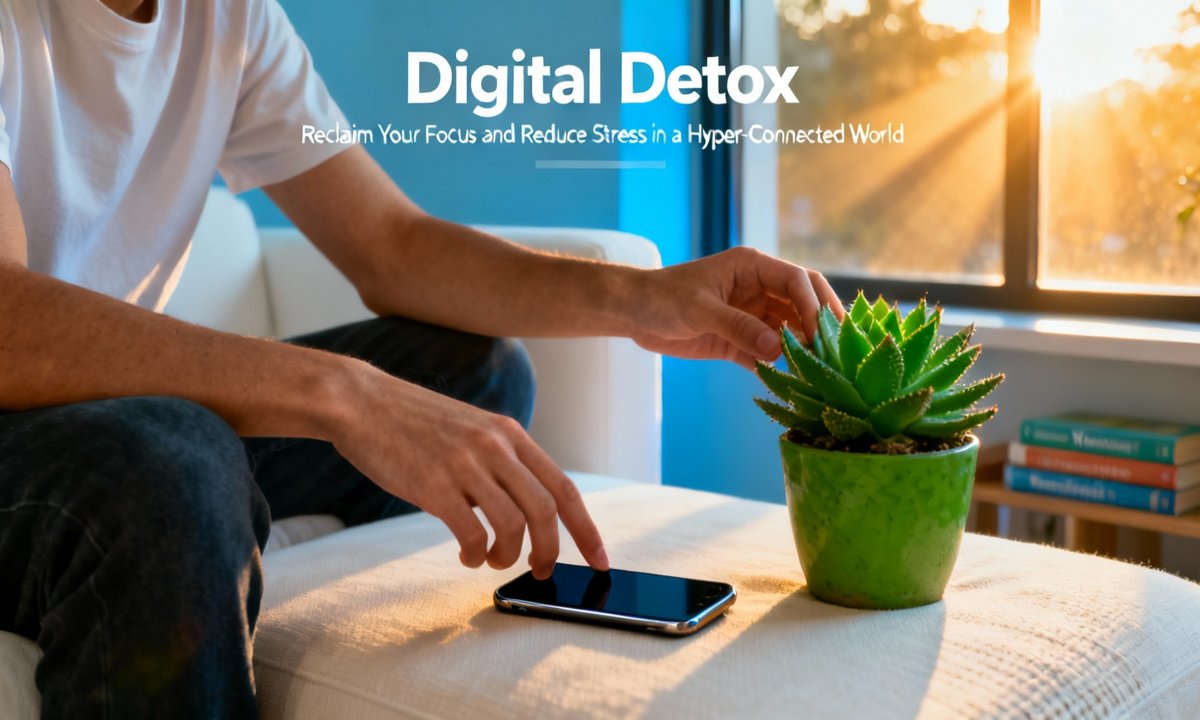A digital detox involves a conscious break from various screens, including phones, laptops, tablets, and smartwatches. This intentional pause aims to reduce stress and help individuals regain focus. In the modern world, daily life is heavily influenced by constant notifications, emails, and social media feeds, making such breaks increasingly vital.
In 2025, many spend over 10 hours daily interacting with digital devices. This extensive usage is associated with increased cognitive fatigue, anxiety, and various physical discomforts. The pervasive nature of technology suggests that truly disconnecting has become a significant challenge for many users today (Cecelia Health, ElectroIQ).
The Impact of Digital Overload on Mind and Body
Digital devices influence our lives constantly, from waking up to late-night online browsing. Adults typically spend over 10 hours daily looking at screens, and teenagers engage for more than 4.6 hours. This continuous online presence can sometimes lead to a feeling of being constantly tied to devices (Nexus Teen Academy).
The consequences extend beyond simply feeling overwhelmed. A significant number of screen users, around 72%, report experiencing “tech neck,” which is discomfort in the neck from prolonged device use. Additionally, 57% notice their eyesight declining, and one in three individuals develop repetitive strain injuries.
The mental health impact is also substantial. Individuals who frequently use social media face a risk of depression that is 3.1 times higher than average. Furthermore, about 64% of adolescents report losing sleep because of late-night screen interactions, highlighting the broad effects of digital engagement (Virtual Addiction).
Why Consider a Digital Detox?
Many individuals are exploring digital detoxes to regain their concentration, protect their mental health, and alleviate feelings of digital burnout. A majority, 64% of people, undertake a digital detox specifically to step away from social media. However, the urge to disconnect often extends beyond social platforms to include work-related emails and frequent online shopping (ElectroIQ).
Excessive digital engagement can diminish creativity, increase fatigue, and detract from being present in the moment. It’s common to instinctively check your phone, spend hours scrolling, or find it hard to disengage even during meals or before sleep. About one in five U.S. adults have already attempted a complete digital detox for these reasons (GWI).
Signs You Need a Digital Detox
You might consider a digital break if you experience stress when your phone is out of reach, or if you struggle with focus and deep reading. Other indicators include poor sleep, persistent mental fatigue, or heightened irritability and anxiety after extended online use. Losing track of time while scrolling or feeling physical tension in your neck and hands are also common signals.
Recognizing these signs can be the first step towards a more balanced digital life. Understanding your relationship with technology is crucial for improving overall well-being.
The Cycle of Detox and Relapse
Embarking on a digital detox presents its own set of challenges. Many who try to step away from social media, streaming, online shopping, or gaming often find themselves reconnecting sooner than planned. The desire to return to digital platforms is significant, with 51% experiencing a relapse after their detox.
Quitting work emails can be particularly difficult for 29% of individuals during a digital break. Despite these challenges, even brief detox periods offer immediate benefits like reduced stress, improved sleep, and stronger real-world connections. These positive outcomes, however, require a sustained strategy to endure (ElectroIQ).
Steps for a Successful Digital Detox
A successful digital detox involves strategic planning and consistent effort to minimize reliance on devices. By following structured steps, individuals can gradually reduce screen time and foster a more balanced lifestyle.
Identify Your Triggers
Begin by understanding your screen habits. Pinpoint the times and activities where you tend to spend excessive, often mindless, hours. This could involve social media, news consumption, gaming, or online shopping. Recognizing these patterns is a crucial first step.
Start Small with Mini Detoxes
Instead of aiming for complete abstinence immediately, consider initiating with shorter, manageable breaks. This might include device-free evenings or half-day weekly breaks. A noticeable trend among detoxers is that 37% choose to delete specific apps, while 23% prioritize keeping devices out of their bedrooms (GWI).
Create Device-Free Zones
Designate specific areas or times as tech-free. For instance, charging devices outside your bedroom can significantly improve sleep quality. Planning meals or walks with loved ones that are entirely free from technology also helps strengthen real-world connections.
Use Tech to Block Tech
Paradoxically, technology can assist in reducing digital overuse. Tools like app blockers are effective, reportedly reducing compulsive checking by 61%. Applications such as Freedom or FocusMe can be valuable aids in managing digital temptations and promoting a more focused environment (Virtual Addiction).
Communicate Your Goals
Sharing your digital detox intentions with family, friends, or colleagues can provide essential social support. This collective awareness often increases the likelihood of success, as your support network can help you stay accountable.
Replace Screen Time with Other Activities
Actively engage in offline pursuits such as cooking, gardening, reading, or physical exercise. Exploring healthy meal prepping can be a rewarding, hands-on activity, offering delicious and economical recipes for the entire week (Mastering Meal Prep: Delicious & Frugal Recipes for the Whole Week).
Design Your Space for Success
A clutter-free environment, both digital and physical, can enhance mental clarity and support your detox efforts. Discover effective strategies for organizing your home and life, creating serene spaces that foster peace and focus (Declutter Your Home: Essential Storage Solutions for Every Room).
Seek Support If Needed
For those facing significant challenges, specialized digital detox programs can be highly beneficial, showing up to a 72% success rate. These programs are particularly effective when combined with professional or behavioral therapy, offering structured guidance and support for lasting change.
Mindfulness and Wellness Techniques
A digital detox offers a valuable opportunity to reconnect with oneself and the surrounding environment. Incorporating mindfulness and wellness practices can significantly enhance the positive outcomes of this break, fostering a deeper sense of well-being.
Practice Mindful Breathing
Engaging in just five minutes of focused breathing can help calm your nervous system and promote inner peace. This simple practice is beneficial before bedtime, during work breaks, or whenever you feel the urge to engage with screens.
Embrace Offline Self-Care Routines
Integrate self-care activities that do not involve digital devices. Journaling can enhance clarity and foster gratitude. Preparing a nourishing meal, perhaps inspired by delicious vegan recipes, offers a fulfilling, hands-on experience (Plant-Based Power: Easy & Flavorful Vegan Recipes). Caring for indoor plants is another soothing activity, known to improve air quality and provide a calming presence (Boost Your Home’s Air Quality: Top 7 Indoor Plants).
Create Calming Environments
Thoughtfully design your living space to promote relaxation and support your digital detox objectives. Elements like soft lighting, comfortable seating, and reduced clutter contribute to a serene atmosphere. Discover innovative ideas for creating an eco-chic, sustainable home environment that nurtures well-being (Eco-Chic: Sustainable Home Decor Ideas).
Reflect on Progress
Periodically review your journey by scheduling regular “digital check-ins.” Observe improvements in your mood, concentration, and sleep patterns. Acknowledge and celebrate every small success, whether it’s an uninterrupted conversation or finding joy in a new hobby.
Real-Life Success Stories
Many individuals have experienced significant positive changes through digital detoxes, illustrating the real-world benefits. These stories often highlight a journey of initial challenges leading to improved well-being and stronger connections.
One individual, a software engineer, successfully removed all social media applications for two weeks and established a no-phone rule in the bedroom. This intentional break led to a profound sense of calm, an increase in reading, and more meaningful in-person interactions with friends.
Another professional, a marketing director, introduced “screen-free Sundays” for his family. While the initial adjustment was challenging, this consistent effort eventually strengthened family relationships and contributed to better sleep for his children. These experiences underscore the value of starting small and persevering.
These personal journeys reveal that early difficulties are common, but dedication, combined with tools like app blockers and a supportive network, can lead to lasting benefits. The key takeaway from these experiences is to begin with small steps, anticipate the urge to reconnect, and recognize that even brief digital breaks yield valuable rewards.
Expert Tips and Mental Health Resources
Guidance from experts often emphasizes that gradual, consistent adjustments are more effective than drastic overnight changes in digital habits. Adopting small, deliberate practices can lead to significant long-term improvements in digital well-being.
One key recommendation is to limit screen exposure before bedtime, which is crucial for promoting deeper and more restorative sleep. For instance, a notable percentage of adolescents, 64%, report sleep loss due to late-night digital activities. It is also advised to disable all non-essential notifications to reduce constant distractions.
Cultivating meaningful offline rituals, such as walking a pet, cooking with loved ones, or engaging in community volunteering, provides enriching alternatives to screen time. Should challenges arise in managing technology use, seeking professional help is encouraged. Therapists and wellness coaches can develop tailored screen management strategies. Behavioral therapy, for example, has shown to enhance digital self-regulation in 83% of participants (Virtual Addiction).
Recommended Resources:
For additional guidance on screen time and its impact on mental health, valuable information can be found through comprehensive guides on healthy technology use. Organizations dedicated to digital wellness and mental health alliances also offer extensive support and information for navigating the digital landscape responsibly.
* Screen Time & Mental Health: APA Guide
* Digital Wellness Collective
* National Alliance on Mental Illness (NAMI)
Frequently Asked Questions
How long should a digital detox last?
The duration of a digital detox can vary depending on individual needs and goals. Even dedicating a few hours each week can be beneficial. Many find a weekend detox effective, while others prefer extending their break to a full week or more. The most important aspect is to find a length that is both challenging and sustainable for you.
Will I lose touch with friends or work?
While communication patterns may shift during a digital detox, it does not mean losing touch entirely. Informing friends, family, and colleagues about your break can manage expectations. Many individuals report that their relationships and overall productivity actually improve through more intentional, focused interactions.
Is a total detox necessary?
A complete abstinence from digital devices is rarely the goal. Most experts advocate for achieving balance and practicing mindful technology use rather than striving for permanent disconnection. The aim is to integrate technology thoughtfully into your life.
What if I relapse?
Experiencing a relapse is a normal part of the process when trying to change habits. Setbacks are an expected component of any personal transformation. If you find yourself returning to old patterns, take time to understand what triggered the relapse and then recommit to your detox goals.
Can digital detox help kids and teens?
Implementing digital detox principles can be highly beneficial for children and teenagers. Establishing clear and consistent guidelines for screen use, coupled with engaging in screen-free family activities, can significantly improve sleep quality and enhance focus, particularly when applied to evening routines.
Resources and Further Reading
For guidance on creating an organized environment that complements digital decluttering, explore practical tips for various rooms in your home (Declutter Your Home: Essential Storage Solutions for Every Room).
If you are seeking engaging, screen-free hobbies, consider the rewarding practice of meal preparation. This activity offers both nourishment and enjoyment, with resources available for crafting delicious and economical recipes for the week (Mastering Meal Prep: Delicious & Frugal Recipes for the Whole Week). Additionally, plant-based power recipes provide healthy and flavorful vegan options (Plant-Based Power: Easy & Flavorful Vegan Recipes).
To create a soothing home environment, discover inspiring eco-chic ideas for sustainable home decor that promotes a stylish and green living space (Eco-Chic: Sustainable Home Decor Ideas for a Stylish & Green Space). You can also enhance air quality and calm your mind by integrating top indoor plants into your home (Top 7 Indoor Plants for a Healthier Living Space).
Key Takeaways
Many adults spend a significant amount of time, often over 10 hours daily, engaged with screens, leading to increased stress and mental fatigue. A digital detox serves as an effective strategy to regain focus, alleviate stress, and foster genuine connections with oneself and others.
Success in a digital detox is often achieved through implementing small, manageable steps. This includes adopting “mini detoxes,” establishing clear boundaries, and integrating device-free rituals into daily life. Engaging in mindful offline activities, such as cooking, gardening, reading, or physical movement, provides profound restorative benefits.
The importance of community and support cannot be overstated; sharing your journey with friends or joining a wellness group can enhance success. If you find yourself overwhelmed by technology, remember that you are not alone, and seeking help is a valuable step towards balance.
Embrace mindful technology use to experience how a digital detox can revitalize your life, one intentional break at a time.



